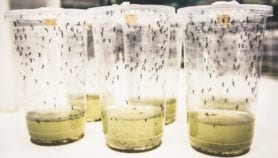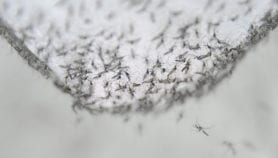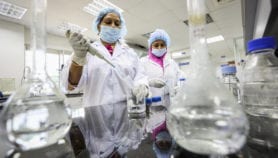By: Mićo Tatalović
Send to a friend
The details you provide on this page will not be used to send unsolicited email, and will not be sold to a 3rd party. See privacy policy.
Scientists have produced new strains of maize that could cut vitamin A deficiency among people in developing countries.
Developed using traditional breeding methods, the vitamin-fortified maize could be introduced instead of maize modified by genetic engineering, a process that continues to face objections.
A research team reports this week in Nature Genetics (22 March) that they have identified rare variations of a gene known as crtRB1, which occur only in maize plants from temperate regions. These result in much higher production — up to 18 fold — of beta-carotene, the precursor and main source of dietary vitamin A. Using natural plant breeding, the researchers have now introduced these variations into tropical maize strains that are commonly grown in developing countries.
Poor people in many developing countries depend on cheap foods such as maize that do not provide enough vitamin A. In Zambia, more than half (53 per cent) of children do not get sufficient vitamin A, and the WHO estimates that up to 500,000 children worldwide are blinded each year by the deficiency, and half of them die of related causes within a year.
HarvestPlus (HP), an international research programme that aims to reduce micronutrient malnutrition, has set a target level of 15 micrograms of beta-carotene per gram of grain, sufficient to prevent vitamin A deficiency in areas where maize is a staple crop, such as many parts of Sub-Saharan Africa, Latin America and India.
"This gene can reach about 57 per cent of the HP target," said Jianbing Yan, lead author of the new study, who is based at the International Maize and Wheat Improvement Center (CIMMYT) in Mexico.
Co-author Torbert Rocheford, of Purdue University in the United States, says the researchers are working with local companies in Zambia and aim to provide farmers in the country with the new maize seeds by 2012.
"The idea is to develop relationships with seed companies and to do a really good job in Zambia and then expand to neighbouring countries that get their seed stock from Zambia," he told SciDev.Net.
Although genetic engineering approaches to enhancing beta-carotene levels in maize have also been successful, there is still reluctance in many African countries to accept GM crops (see GM corn comes a step closer to a complete meal).
"Rice breeders around the world have made every effort to find similar [natural] variation in rice but have not been successful," said Ingo Potrykus, co-inventor of Golden Rice, genetically engineered to have high vitamin A levels, and chairman of the Golden Rice Humanitarian Board. "But this is solid work in traditional maize breeding and the result should have some positive impact."
"I think the idea of vitamin A-enhanced crops using modern breeding techniques is a very promising field," said Guillaume Gruère, a research fellow at the International Food Policy Research Institute. "But success is not guaranteed — it would depend on the technology being brought to countries and passing registration requirements, and being successfully distributed to and used by farmers."
Link to full paper in Nature Genetics
References
Nature Genetics doi 10.1038 (2010)













